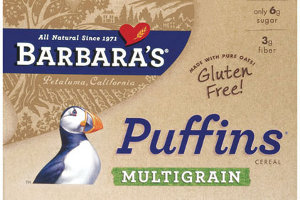August 2011/Prepared Foods -- Datamonitor, in its “Bakery and Cereals in the U.S. to 2014” report, found the market for bakery and cereals in the U.S. increased at a compound annual growth rate of 2.2% between 2004-2009, and the firm’s Product Launch Analytics noted nearly a 33% surge in new cereals released over the course of 2010, compared with 2009. The 377 total launches were the largest number of introductions in over five years. Cereal bars had similar results: the 550 releases in 2010 were 37% ahead of 2009’s pace.

|
|
For its addition to the Pebbles cereal family, Post Foods LLC added whole grains and the taste of caramel apple, to deliver a cereal with 100 calories, 8g of sugar and 10 essential vitamins and minerals per serving. |
According to NPD Group, the average consumer takes roughly 13 minutes per day to prepare and eat breakfast. In fact, per a Kellogg’s survey of 14,000 Americans of “varying ethnicities, income levels, geographic regions and ages,” more than half (54%) of all adults would like to eat breakfast every day. Somewhat surprisingly, considering that limited amount of time devoted to the morning meal, sales of ready-to-eat cereals are slipping. Per Symphony/IRI data, these cereals garnered $6.41 billion in sales over the 52 weeks ending mid-April 2011, a 2.6% drop from the prior year. Furthermore, the drop cannot be blamed on growth of private label options: their $637.5 million in sales was a 7.3% decline. Cereals face competition from new quarters, including microwaveable breakfast options; renewed focus on breakfast at the foodservice level; and even a governmental focus on the use of animated characters in marketing efforts.
Free and Clear
Among the most active trends in recent years have been allergen-friendly products, and the cereal aisles have been no stranger to these innovations. Appearing on store shelves in late spring 2011, Kellogg’s Rice Krispies Gluten Free, the company’s first-ever, gluten-free cereal, resulted from simple consumer demand, notes Doug VanDeVelde, senior vice president of marketing and innovation at Kellogg’s. “We heard the strong desire from people within the gluten-free community, especially parents, for more affordable foods that they can serve their families, and we are helping to fill that need.” Indeed, in terms of affordability, Kellogg’s notes the suggested retail price for Rice Krispies Gluten Free is the same as the original cereal, not exactly common among gluten-free options.
To remove gluten from Rice Krispies, Kellogg’s developers have eliminated barley malt (the source of gluten in the original variety) and turned to whole-grain brown rice, both to differentiate it from the original and for flavor. To eliminate the risk of cross-contamination, Rice Krispies Gluten Free is produced in a separate facility, which the company notes has been making gluten-free products for nearly a decade. Each batch of cereal also is tested to ensure it is free of gluten, as is the entire production line, the company notes. The cereal is fortified with several vitamins and minerals, contains 120 calories, less than 1g of sugar, 1g of fat and fiber, 3g of protein and 190mg of sodium per serving.
Kellogg’s may be one of the latest and largest entrants into gluten-free cereals, but it is far from alone in the segment. In fact, it follows the lead of a series of gluten-free cereals General Mills released in 2009. Gluten-free Chex was available in rice, corn, honey nut, cinnamon and chocolate varieties, and, during the launch, General Mills noted only 41% of gluten-free dieters consumed ready-to-eat cereal, compared with 93% of the general population. General Mills’ website also features another interesting piece of research: it claims 20% of the U.S. population is “trying to reduce gluten consumption,” with 7% “avoiding gluten completely.” (Visit: http://bit.ly/ql9joD)
Barbara’s has added a multigrain option to its line of all-natural, gluten-free cereals; every batch is tested to ensure the allergen is not present, per Kent Spalding, Barbara’s vice president of marketing. Puffins Multigrain cereal is made with whole-grain pure oats, brown rice and corn pillows, and it also features a natural prebiotic fiber. In every serving is 8g of whole grains (16% of the daily recommended allotment), and each promises to be high in calcium, a good source of fiber, and an excellent source of vitamins C and D and iron, while also free of artificial flavors, additives and preservatives.

|
|
The gluten-free trend, while not having quite the same impact in cereals as in other categories, has made some advances into cereals, with a pair of major introductions of late, including Barbara’s Puffins, a multigrain addition to its line of all-natural, gluten-free cereals. |
Multigrains were likewise found in Post Foods LLC’s latest launch, under its Honey Bunches of Oats brand. Raisin Medley featured three different kinds of sun-ripened raisins (natural seedless, jumbo seedless and flame-red grapes), crispy multigrain flakes and oat clusters, with each serving promising 12g of whole grains, nine essential vitamins and minerals, and 0g of trans fat, saturated fat or cholesterol. Perhaps most notable about this launch was the marketing campaign behind it: Raisin Medley was featured on “Honey & Joy,” the first mobile content series available on Bitbop, a commercial-free, on-demand mobile TV service. The eight-episode comedy series was set in a Honey Bunches of Oats factory, and more than 12 million boxes of the cereal featured a QR code offering free trials of the Bitbop service.
Bar Exam
Of course, cereals are not confined merely to the breakfast aisles, and with whole grains a feature of cereals, it should be no surprise to see them in cereal bars. Clif Kid’s Zbar Crispy is an organic rice crispy snack extension of the original baked Organic Zbar line. Available in child-friendly flavors, such as chocolate, chocolate chip and peanut butter, the Clif Kid version is made with 8g of whole grains, as well as toasted oats, for what the company describes as a “lightly textured crunch.” Like its original namesake, Zbar Crispy promises a balanced blend of carbohydrates, protein, fiber and healthy fat, all with the goal of curbing hunger and stabilizing energy levels. As Tara DelloIacono-Thies, R.D. for Clif Bar & Company, notes, “Kids’ growing bodies have unique nutritional needs that differ from adults. Zbar Crispy offers calcium, iron, zinc and vitamin D...nutrients essential for kids’ growing bodies, but often lacking in their meals and snacks.”
Also new on the bar scene is Kashi Company’s TLC Peanutty Dark Chocolate Layered Granola Bars, joining the brands’ other TLC bar flavors of Dark Chocolate Coconut and Pumpkin Pecan. Each bar is made with Kashi’s blend of seven whole grains and promises the taste of peanuts with dark chocolate, to deliver what Kashi calls “a sweet and savory flavor combination the whole family can enjoy.” The TLC Peanutty Dark Chocolate Layered Granola Bar begins with a granola base made with peanut butter and peanut chunks. Atop that is a thick layer of real, soft fruit mixed with dark chocolate and roasted Runner peanuts. Free of high-fructose corn syrup (HFCS), artificial flavors and preservatives, each bar purportedly contains 7g of whole grains, 4g of fiber and 4g of protein (from peanuts and soy crisps), as well as 4.5g of fat, per one-bar serving.
With the increasing focus on weight management, cereal bars likewise have turned to new options to meet this particular consumer demand. Kellogg’s Special K cereal bar portfolio was almost reinvented with the addition of 3g of fiber and two new, dessert-inspired flavors: Chocolatey Chip Cookie and Raspberry Cheesecake. However, the fiber addition was made to a number of the pre-existing Special K bars, including blueberry, Chocolatey Drizzle, Chocolatey Pretzel, honey nut, peaches and berries, strawberry and vanilla crisp. According to Kellogg’s, fewer than one in 10 Americans get enough fiber on a daily basis.
The whole-grain movement has been especially strong in cereals over the past several years, spurred at least in part by studies into the health benefits of whole-grain cereals. One, in fact, found eating breakfast cereal, particularly whole-grain cereal, may reduce the risk of developing high blood pressure.
“We found about a 20% decreased risk of developing hypertension in those who consumed whole-grain breakfast cereals at least 7 times/week,” commented lead researcher Dr. Jinesh Kochar, of Beth Israel Deaconess Medical Center in Boston and the VA Boston Healthcare System. “Along with other healthy lifestyles, such as low sodium intake and physical activity, getting whole grains from this readily available source can cut down the risk of developing chronic hypertension.” He presented findings from the study, which received no private industry funding, at the March 2011 American Heart Association conference in Atlanta. For the study, Kochar’s team collected data on 13,368 male doctors who took part in the Physicians Health Study I, a trial begun in 1982. None of the men had high blood pressure at the onset of the study, but during more than 16 years of follow-up, 7,267 men developed hypertension. The men were separated into four groups based on their cereal consumption.
When researchers adjusted only for age, they found the men who ate cereal at least once a week reduced their risk of high blood pressure 8% compared with men who ate no cereal. Consuming cereal 2-6 times/week lowered the risk 16%, and eating it 7+ times/week dropped the risk 25%.
When Kochar’s group adjusted their findings for smoking history, weight, alcohol intake, fruit and vegetable consumption, physical activity and history of diabetes, in addition to age, the difference was still significant, but smaller: 12% for those eating 2-6 servings/week and 19% for men eating 7+ bowls.
The association with lower blood pressure was stronger for whole-grain cereals, possibly because of whole-grain cereal’s high fiber content. pf

